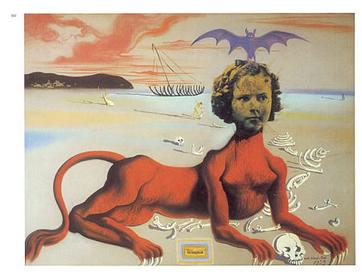Thursday, July 19, 2012
FILM 14: DALI / LOW
The biggest difference in this film is that there are interviews and other videos that are of Dali. No other artist we have focused on has been interviewed like Dali is in this film. These videos gave an even better and more credible insight into the life of Dali. Adam Low used many other strategies to deliver information about Dali. Some include: news reports about Dali, interviews with other people, book excerpts, narration, and finally examples of paintings. In my opinion, the book excerpts were the most effective, followed by the interviews with Dali, the narration, the other interviews, examples of paintings, and finally the narration. I found the excerpts from Dali’s book to be the most effective and interesting because as the narrator talked about Dali, the book backed up the information.
Dali’s “Shirley Temple, The Youngest, Most Sacred Monster of the Cinema in Her Time” is the most interesting painting from this film. In my eyes, it is different from most of Dali’s other paintings based on the subject. I would have not expected something including Shirley Temple to be done by Dali. This painting was created using gouache, pastel, and collage on cardboard. The first thing I see is the red body that Shirley Temple’s head has been attached to. It seems to be part human, part monster. The red color really catches your eye along with the muscle and claws. Next, I see Shirley’s head which seems to be glued on the cardboard. The color does not match the rest of her “body” so that makes it interesting. Her facial expression oddly goes with the pose. Dali’s message is unclear to me, but according to Wikipedia, many sources believe that it is “a satire of the sexualization of child stars by Hollywood”.
The way that Andre Breton, Man Ray, Marcel Duchamp and Dali worked together in Paris was surreal. This changes the way that art and artists interact because it is like the artist is living the art he or she is creating. They are closer. The audience, however, may be distanced from the art because they may not be able to relate to how the artist was feeling or acting when they created such art. This kind of painting is acceptable, but many people might not understand it. People might think it to be odd and they might not like the artwork, but this does not mean it is unacceptable. The irrational way in which these artists lived is interesting for sure, but once again might not make sense to outsiders. While I’m sure it made perfect sense to Dali and the other men, people just might find it unacceptable. They were doing no harm, so there is no reason to consider their way of life unacceptable.
Question: What do you think of Dali’s collaboration with Alfred Hitchcock?
Subscribe to:
Post Comments (Atom)



Id like to comment on your interpretation of the Shirley Temple picture.
ReplyDeleteI agree with you completely in how your eye travels from one element to another. That red body stands out like a sore thumb for sure, as does the face of the sweet child. Yet her expression is somewhat Sphinx-like when attached to that body. Its very unsettling to look at for too long. With the color of the body, I can see how this could be the sexualization of child stars. Plus the bones lying at her feet could symbolize the death of her true childhood and the evolution into the Cinema 'monster' she has become. Great post!